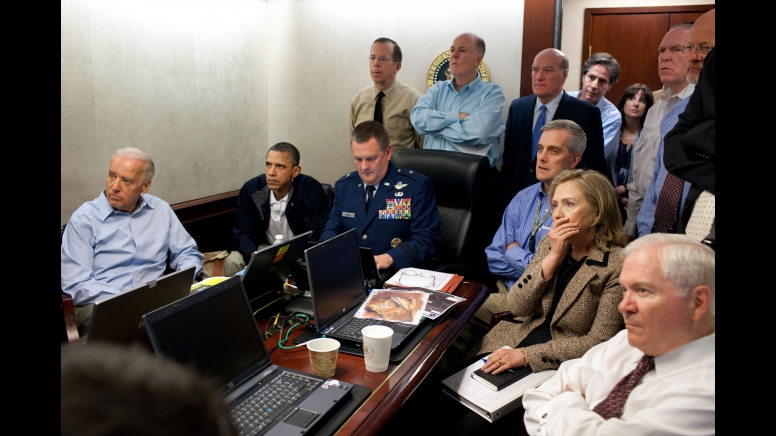By Doug Doan
Today’s Washington Post has an interesting article about the now-famous photo of the President and his national security team meeting in the Situation Room during operations to hunt and kill Bin Laden. Typical of the Washington Post, they miss the most important part of the story and get many of the facts wrong. What a pity: the picture is actually quite informative, and a careful look will help anyone better understand President Obama’s views on how to combat terrorism.
First, lots of press stories have reported the Situation Room event as a meeting of the National Security Council (NSC). It wasn’t. Formal membership and inclusion into the NSC was established by President Obama in his first national security directive (PDD-1). In that directive, Obama expanded the membership of the NSC to include the Attorney General, Secretary of Treasury, Secretary of Homeland Security, the US Ambassador to the UN, and the Chief of Staff to the President. These new members joined the statutory NSC members (President, Vice President, Secretary of State, Secretary of Defense, Secretary of Treasury, Chairman of the Joint Chiefs, the Nationals Security Advisor, and the Director of National Intelligence).
Put another way, in making the decision on how to deal with Bin Laden, President Obama, like all presidents before him, decided to bring together people that he needed and trusted. Some of the members of the NSC didn’t make the cut. Either the President did not need them or did not want them in on the key decisions to deal with bin Laden.
Nothing wrong with that. After all, Presidents before Obama have made similar decisions.
President Kennedy, after becoming frustrated with a too-rigid NSC system, added the Attorney General (his brother, Bobby Kennedy) because he needed a strong (and loyal) voice in national security issues in the wake of a failed effort at the Bay of Pigs. Other presidents have made similar moves too. During my tenure as a young Situation Room Watch Officer, President Reagan created a Crisis Management Center within the NSC, and often brought key experts into the discussions.
That brings us back to the picture. Clearly, the folks Obama brought together were the people he most valued and trusted to put the plan together. Not surprisingly, key members of the NSC are all there: the VP, Sec of State, DoD, NSC Advisor, White House Chief of Staff, and the Director of National Intelligence. Nor should we be surprised by the inclusion of NSC staffers for Counter Terrorism.
But where is the Secretary of Homeland Security and the Attorney General? President Obama’s first national security directive (PDD-1) made them members of the NSC, but they were excluded from the most important national security decision of the Obama Administration. Why?
Homeland Security Secretary Janet Napolitano, would have been the Cabinet Officer most responsible for understanding potential problems in the Muslim community associated with any retaliation. Attorney General Eric Holder would have been the guy most responsible for providing advice on the legalities of a U.S. strike in a foreign country.
Interestingly, after the wild euphoria over the successful hit on Bin Laden, the biggest questions have been over whether to publish a picture and the impact such publication might have to inflame passions (Napolitano’s issue) and the legality of a military strike in Pakistan (Holder’s issue).
Obviously, the President did not think he needed Napolitano or Holder at the meeting. My guess is that he probably concluded that the NSC staffers could provide him that information, so there was no requirement of the Secretary of Homeland Security or the Attorney General. There is also the practical issue of space limitations. The Sit Room is actually (and by design) quite small, so it is not possible to bring in a large group of people.
Of course, the optimist in me thinks there might be something else involved. Both Napolitano and Holder represent the “law enforcement” side of the war on terrorism, as opposed to the more muscular warfare side of the equation, heavily dominated by the military.
One thing seems certain: Presidents build confidence in their staffs over time and nothing builds more confidence than success. The people in the room with Obama during the Bin Laden events have a new rapport and have grown in stature as a result of the successful strike. Their stars are all rising.
In the future, I would expect Obama to turn to his White House and NSC staff for advice and counsel rather than seek that same advice from Cabinet Secretaries like Napolitano and Holder. President Obama obviously trusts the advice he is getting from his staff. No doubt, too, the President is better served by the fact that none of his White House of NSC staff need fear being grilled about their deliberations by Congress.
The downside is that morale at the Department of Homeland Security (which has never been very good) is probably at a new low as they can’t help but notice that their department was not much involved as the biggest and most important decision on terrorism was made.



